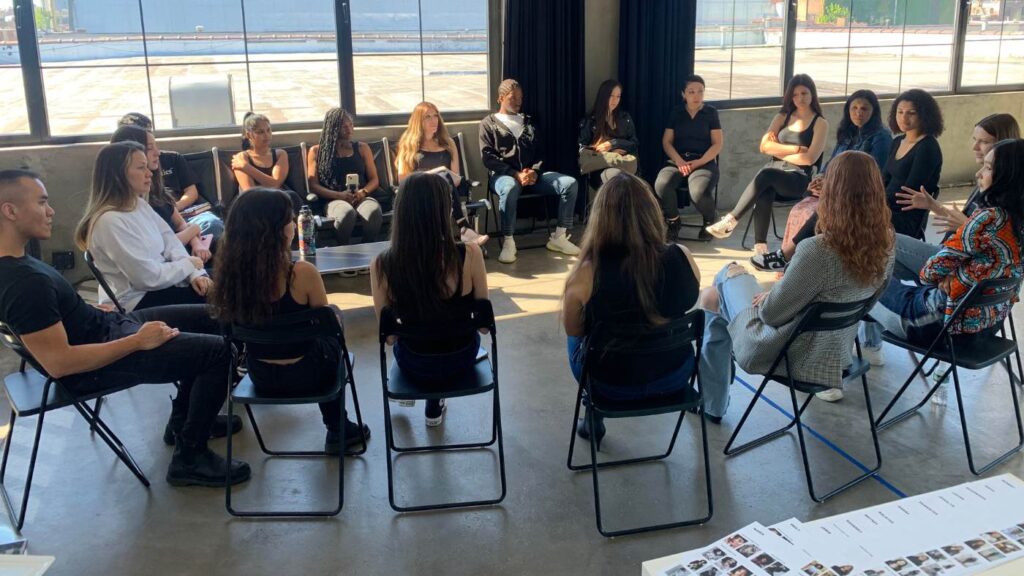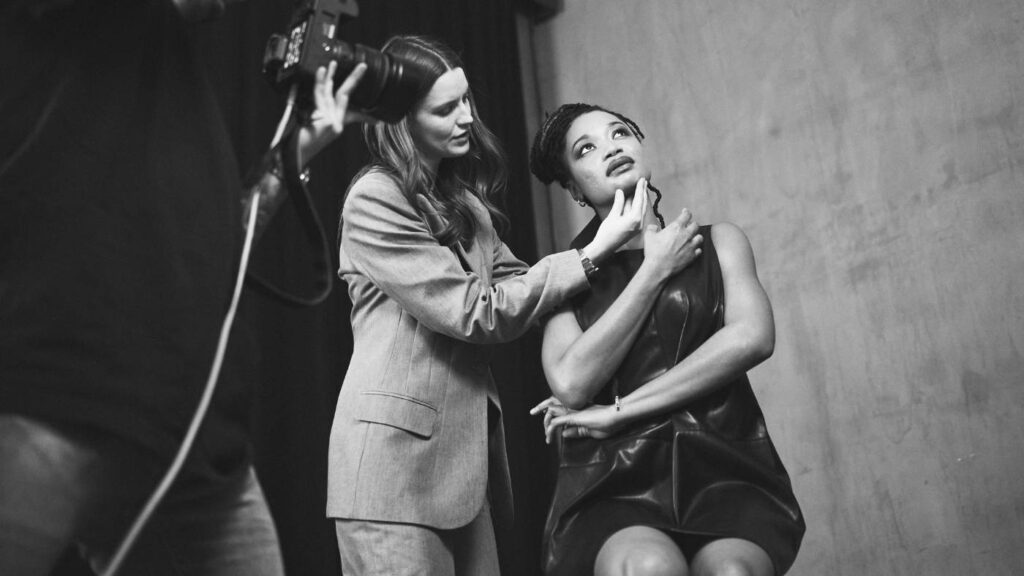The world of modeling has always held a certain allure, captivating the hearts and dreams of countless individuals. The glamorous runways, the vibrant fashion shoots, and the opportunity to be in the spotlight evoke a sense of excitement and possibility. For many aspiring models, this passion extends beyond mere admiration and becomes a burning desire to turn their dreams into a profession.
The journey from passion to profession in the modeling industry is a unique and challenging path that requires dedication, perseverance, and a strong foundation of knowledge and skills. While natural talent and physical attributes play a role, it is the comprehensive training and education received in modeling schools that often pave the way for success.
This blog explores the transformative journey aspiring models embark upon as they navigate through various schools and institutions to acquire the essential skills needed to thrive in the modeling industry. We will delve into the importance of understanding the dynamics of the modeling world and the benefits of proper education and training. From researching and selecting the right modeling school to overcoming challenges and building a network, we will provide insights and guidance for those who dream of turning their passion for modeling into a fulfilling profession.
Throughout this journey, aspiring models encounter numerous obstacles, face fierce competition, and deal with personal doubts. However, armed with the right knowledge and skills, they can develop the resilience necessary to overcome these challenges and find their place in the industry.
By examining the curriculum offered in modeling schools, we will shed light on the essential skills and training required for success. From mastering posing techniques and runway walking to developing portfolios and enhancing self-presentation skills, modeling schools provide a comprehensive foundation for aspiring models to hone their craft.
Moreover, we will explore the significance of networking and industry exposure in the modeling world. Building connections with industry professionals and fellow models can open doors to exciting opportunities and increase visibility within the industry.
As the modeling landscape continues to evolve, we will also discuss emerging trends in modeling education, such as online courses and virtual training. The advent of technology and the influence of social media have reshaped the industry, requiring models to adapt and embrace new platforms to showcase their talents.
To inspire and motivate, we will share success stories of models who started their journey in modeling schools. These stories of passion, perseverance, and dedication will serve as reminders that with the right training, education, and determination, aspiring models can achieve their dreams and carve out a successful career.
So, whether you are a budding model eager to take the first step or an enthusiast seeking insight into the world behind the glitz and glamour, join us as we embark on this enlightening exploration of the journey from passion to profession in the modeling industry. Together, let us uncover the invaluable lessons and experiences that shape the path to success and fulfill dreams beyond imagination.

Understanding the Modeling Industry
The modeling industry is a complex and multifaceted world that encompasses various aspects of fashion, beauty, advertising, and entertainment. It is a dynamic and highly competitive field that demands not only physical attractiveness but also professionalism, versatility, and the ability to adapt to ever-changing trends.
One of the first steps in embarking on a journey through schools for modeling is gaining a comprehensive understanding of the industry itself. This understanding will not only inform aspiring models about the expectations and challenges they may face but also highlight the importance of proper training and education in navigating this unique profession.
The modeling industry thrives on visual representation and the promotion of products, brands, and ideas. Models play a crucial role in bringing these visions to life through their physical appearance, poise, and ability to convey emotions and messages. They become the canvas upon which designers, photographers, and marketers showcase their creations and concepts.
It is essential to recognize that the modeling industry extends far beyond the glamorous runway shows and high-profile fashion campaigns often associated with it. While fashion modeling certainly holds a prominent position, other areas such as commercial modeling, print modeling, fitness modeling, and even niche markets like plus-size or petite modeling offer diverse opportunities for aspiring models.
Furthermore, understanding the demands of the modeling industry is crucial. Models are expected to maintain a certain physical standard, which often includes factors such as height, weight, proportionate features, and overall grooming. While these standards have evolved over time to become more inclusive, it is important to acknowledge the prevalent expectations within the industry.
Attending modeling schools not only imparts technical expertise but also emphasizes the importance of self-presentation, professionalism, and confidence-building exercises. Models must learn to carry themselves with grace and poise, as well as develop the ability to adapt to different styles and work with diverse teams.
Moreover, modeling schools often provide valuable industry insights and connections, offering students the opportunity to interact with industry professionals such as photographers, stylists, and casting directors. These connections can prove instrumental in kickstarting a modeling career and gaining valuable exposure within the industry.
By gaining a comprehensive understanding of the modeling industry, aspiring models can set realistic expectations, recognize the potential challenges they may face, and appreciate the significance of proper training and education. Armed with this knowledge, they can make informed decisions when researching and selecting the right modeling school to embark on their journey to a successful modeling career.

Researching and Selecting the Right Modeling School
Embarking on a journey through schools for modeling requires careful consideration and research to find the right institution that aligns with your goals, aspirations, and learning needs. The modeling school you choose can significantly impact your education, network, and future opportunities in the industry. Here are key steps to help you research and select the right modeling school:
- Determine Your Goals: Start by defining your modeling goals and aspirations. Are you primarily interested in fashion modeling, commercial modeling, or another niche? Clarifying your goals will guide you in finding a modeling school that specializes in your area of interest.
- Seek Recommendations and Reviews: Reach out to professionals in the industry, experienced models, and others who have attended modeling schools. Ask for their recommendations and insights on reputable institutions. Additionally, read online reviews and testimonials from students who have previously enrolled in modeling schools to gather a broader perspective.
- Consider Reputation and Accreditation: Look for modeling schools with a solid reputation and accreditation. A well-established and respected institution is more likely to offer comprehensive and quality education. Check if the school is affiliated with industry organizations or if its graduates have found success in the modeling industry.
- Evaluate the Curriculum: Review the curriculum offered by each modeling school you are considering. Look for a well-rounded program that covers essential skills such as posing techniques, runway walking, portfolio development, and image grooming. The curriculum should align with your specific modeling interests and provide a comprehensive foundation for your career.
- Location and Accessibility: Consider the location of the modeling school and whether it is easily accessible to you. Attending a school in a major fashion hub can provide more opportunities for exposure and networking within the industry. However, also consider factors such as cost of living and the availability of support systems if you are planning to relocate.
- Alumni Success: Investigate the success stories of the modeling school’s alumni. Have their graduates found representation with reputable modeling agencies or secured notable modeling gigs? Alumni success can be a testament to the quality of education and opportunities provided by the school.
- Visit the School and Attend Open Houses: Whenever possible, visit the modeling schools you are interested in. Attend open houses or informational sessions to get a firsthand experience of the school’s environment, facilities, and faculty. Interact with current students and instructors to gain insights into their experiences.
- Financial Considerations: Evaluate the cost of tuition and any additional expenses associated with attending the modeling school. Consider your budget and financial resources, as well as any available scholarships or financial aid options. Remember to weigh the cost against the potential benefits and opportunities the school can provide.
- Trust Your Instincts: Ultimately, trust your instincts when selecting a modeling school. Consider how comfortable you feel with the school’s environment, values, and teaching methods. Choose a school where you believe you will thrive and receive the necessary support to achieve your modeling aspirations.
By conducting thorough research and considering these factors, you can make an informed decision when selecting the right modeling school for your journey. Remember that the right institution can provide you with the necessary skills, knowledge, and connections to launch a successful modeling career.

Modeling School Curriculum: Essential Skills and Training
A key component of the journey through modeling schools is the curriculum offered by these institutions. The curriculum is designed to equip aspiring models with the essential skills and training required to excel in the industry. Let’s explore some of the core areas covered in a typical modeling school curriculum:
- Posing Techniques: Modeling schools emphasize the art of posing, teaching students how to position their bodies and showcase different garments or products effectively. From understanding body angles and lines to conveying emotions through poses, students learn the nuances of creating impactful visual compositions.
- Runway Walking: Walking the runway is a fundamental skill for fashion models. Modeling schools provide instruction on runway techniques, teaching students how to achieve poise, grace, and confidence while walking in sync with music and maintaining a consistent pace. Runway training also includes mastering turns, poses, and conveying a strong presence on the catwalk.
- Portfolio Development: A strong modeling portfolio is crucial for showcasing versatility and attracting potential clients and agencies. Modeling schools guide students in creating a professional portfolio, including high-quality photographs that highlight their range and suitability for different modeling genres. They learn how to curate a diverse selection of images that demonstrate their unique qualities as models.
- Grooming and Styling: Models must pay attention to their personal grooming and presentation. Modeling schools often include grooming and styling sessions where students learn about skincare, makeup application, hairstyling, and proper wardrobe selection. These skills ensure that models are well-prepared to meet industry standards and exude a polished appearance.
- Self-Presentation and Confidence-Building: Confidence is key in the modeling industry. Schools focus on building students’ self-esteem, teaching them how to carry themselves with poise, project confidence, and effectively communicate with clients, photographers, and other industry professionals. Public speaking exercises and body language training contribute to the development of a strong, confident presence.
- Fashion Industry Knowledge: Modeling schools provide insights into the inner workings of the fashion industry. Students learn about fashion history, industry terminology, current trends, and the roles of various professionals involved in fashion production, such as designers, stylists, and photographers. This knowledge helps models understand the broader context of their work and collaborate effectively within the industry.
- Etiquette and Professionalism: Professionalism is highly valued in the modeling industry. Modeling schools teach students about professional etiquette, including punctuality, respect, and effective communication. They learn about the expectations and protocols of castings, auditions, and photo shoots, ensuring that they conduct themselves appropriately in various professional settings.
- Health and Fitness: Physical well-being is important for models. Many modeling schools emphasize the importance of maintaining a healthy lifestyle, including exercise, nutrition, and mental well-being. Students learn about maintaining an optimal physique, managing stress, and developing healthy habits to support their overall well-being throughout their modeling careers.
- Industry Connections and Networking: Modeling schools often provide opportunities for students to interact with industry professionals and establish valuable connections. They may organize guest lectures, workshops, or events where students can meet established models, agents, photographers, and other influential individuals in the field. These networking opportunities can open doors to future collaborations and career advancements.
- Ongoing Support and Guidance: Modeling schools offer ongoing support and guidance to students throughout their journey. This may include mentorship programs, career counseling, or assistance with portfolio updates and auditions. The support system provided by the school helps students navigate the challenges of the industry and stay motivated on their path to success.
By incorporating these essential skills and training areas into their curriculum, modeling schools equip aspiring models with the tools they need to succeed in the industry. The comprehensive education received in these institutions lays a strong foundation for a successful career, helping models stand out and excel in a competitive field.

Navigating the Challenges of Modeling School
While modeling schools offer valuable education and training, the journey through these institutions is not without its challenges. Aspiring models often face various obstacles and must develop the resilience and determination to overcome them. Here are some common challenges faced by students in modeling schools and strategies for navigating them:
- Intense Competition: The modeling industry is highly competitive, and this competitiveness is often reflected within modeling schools. Students may find themselves surrounded by talented individuals all vying for similar opportunities. To navigate this challenge, focus on your own growth and development rather than comparing yourself to others. Embrace a growth mindset, constantly strive to improve, and celebrate your own progress.
- Rejection and Criticism: Rejection is a common part of the modeling industry, and students in modeling schools may face rejection during auditions, castings, or even in the classroom. It’s important to remember that rejection does not define your worth or talent. Instead, view it as an opportunity to learn and grow. Use constructive criticism as a tool for improvement and let setbacks fuel your determination to succeed.
- Body Image Issues: The modeling industry often places emphasis on specific body standards, which can lead to body image concerns among aspiring models. It’s crucial to prioritize your mental and physical well-being. Focus on cultivating a positive body image and adopting healthy habits rather than striving for an unrealistic ideal. Surround yourself with a supportive network of friends, family, and mentors who celebrate your individuality and promote a healthy self-image.
- Balancing Education and Modeling: Many aspiring models attend modeling schools while simultaneously pursuing their education. Managing the demands of both can be challenging, requiring effective time management and organization. Develop a schedule that allows for dedicated time for both academic and modeling pursuits. Seek support from teachers, modeling school faculty, and family to help maintain a healthy balance and ensure you excel in both areas.
- Self-Doubt and Confidence: The journey through modeling school can be filled with moments of self-doubt. It’s normal to question your abilities and compare yourself to others. Remember that confidence is a skill that can be developed. Practice self-affirmation, surround yourself with positive influences, and celebrate your strengths and achievements. Push yourself out of your comfort zone and embrace opportunities that challenge and build your confidence.
- Time and Financial Constraints: Attending modeling school may require a significant investment of time and finances. This can create additional stress and pressure. Develop a realistic financial plan and explore scholarship or financial aid options that may be available. Prioritize your commitments and create a schedule that maximizes your time and resources. Seek part-time jobs or flexible opportunities that align with your modeling aspirations to support your financial needs.
- Maintaining Focus and Motivation: The path to a successful modeling career can be long and filled with ups and downs. It’s essential to stay focused and motivated throughout your time in modeling school. Set clear goals for yourself and regularly remind yourself of why you embarked on this journey. Surround yourself with like-minded individuals who inspire and support your aspirations. Celebrate milestones along the way to maintain a sense of accomplishment and enthusiasm.
By acknowledging and proactively addressing these challenges, you can navigate the journey through modeling school more effectively. Remember that perseverance, self-belief, and a positive mindset are essential ingredients for success in the face of adversity. Embrace challenges as opportunities for growth and keep your eyes fixed on your ultimate goal of a fulfilling and rewarding career in the modeling industry.

Networking and Industry Exposure
In the modeling industry, networking and industry exposure play a vital role in opening doors to opportunities and advancing your career. Building connections with industry professionals, fellow models, and influential individuals can significantly impact your visibility and success. Here are some key considerations for effective networking and gaining industry exposure:
- Attend Fashion Events and Shows: Actively participate in fashion events, runway shows, trade shows, and industry gatherings. These events provide opportunities to connect with designers, agents, photographers, and other influential individuals in the industry. Attend fashion weeks, local fashion shows, and industry conferences to immerse yourself in the fashion community and make valuable connections.
- Engage with Social Media: Utilize social media platforms strategically to enhance your visibility and networking potential. Create a professional social media presence, showcasing your portfolio, work, and industry insights. Follow and engage with industry professionals, brands, and fellow models. Participate in relevant online conversations, collaborate with other creators, and leverage social media platforms to showcase your personality and unique style.
- Build Relationships with Industry Professionals: Actively seek opportunities to connect with industry professionals. Attend casting calls, go-sees, and open calls hosted by modeling agencies or fashion brands. Introduce yourself, express your interest, and make a lasting impression. Be professional, punctual, and respectful in all interactions. Building positive relationships can lead to future collaborations, referrals, and career advancements.
- Collaborate with Emerging Designers and Photographers: Connect with emerging designers and photographers who are looking to build their portfolios. Collaborative projects allow you to gain experience, expand your network, and create mutually beneficial relationships. Reach out to local designers, photographers, and stylists to explore opportunities for creative collaborations and innovative projects that showcase your versatility.
- Seek Mentorship and Guidance: Identify experienced professionals in the industry who can provide mentorship and guidance. A mentor can offer valuable insights, advice, and industry knowledge, helping you navigate the challenges and make informed decisions. Seek mentorship from established models, agents, or other industry insiders who are willing to share their expertise and support your growth.
- Engage in Model Workshops and Masterclasses: Participate in model workshops and masterclasses hosted by industry experts. These educational events provide valuable networking opportunities while enhancing your skills and knowledge. Workshops often feature guest speakers, photographers, and stylists who can offer industry insights and valuable connections. Take advantage of these learning opportunities to expand your network and gain exposure.
- Leverage Online Modeling Communities: Join online modeling communities and forums to connect with fellow models and industry professionals from around the world. These communities offer a platform to share experiences, seek advice, and collaborate on projects. Engage actively, contribute valuable insights, and make genuine connections within these online communities.
- Maintain Professionalism and Follow Up: Always maintain professionalism in your interactions with industry professionals. Be punctual, reliable, and respectful of others’ time and commitments. After networking events or meetings, follow up with a thank-you note or email to express your appreciation and reinforce the connection. Building strong professional relationships is a continuous effort that requires consistent communication and follow-up.
Remember that networking is a two-way street. Be genuine, approachable, and supportive of others in the industry. Networking is not just about what you can gain, but also about how you can contribute and collaborate with others. Embrace networking as an opportunity to build meaningful relationships, learn from industry experts, and create a strong support system throughout your modeling journey.

Success Stories: Inspiring Examples of Models Who Started in Schools
The modeling industry is filled with inspiring success stories of individuals who started their journey in modeling schools and went on to achieve remarkable careers. These stories serve as a testament to the transformative power of education, training, and dedication. Here are a few notable examples of models who began their path to success in modeling schools:
- Gisele Bündchen: Widely regarded as one of the most successful supermodels of all time, Gisele Bündchen started her modeling career after attending a modeling school in Brazil. Her natural beauty and charisma, combined with the skills she acquired through education and training, propelled her to become an international icon and a sought-after name in the industry.
- Karlie Kloss: Karlie Kloss attended a modeling school in her hometown of St. Louis before rising to prominence in the fashion world. Her education and training played a significant role in developing her signature runway walk, impeccable posing techniques, and versatile modeling skills. Karlie went on to work with renowned fashion houses, grace countless magazine covers, and become a role model for aspiring models worldwide.
- Tyra Banks: Before becoming a household name and an influential figure in the modeling industry, Tyra Banks honed her skills at a modeling school. Her determination, combined with the education she received, allowed her to break barriers and achieve success as a runway and print model. Tyra later used her experiences to empower aspiring models as the host and creator of the popular reality TV show “America’s Next Top Model.”
- Liu Wen: Liu Wen, one of the first East Asian models to achieve global recognition, began her modeling journey after attending a modeling school in China. Her training equipped her with the necessary skills to conquer the international fashion scene. Liu Wen has since become a prominent figure in the industry, walking for prestigious brands, gracing magazine covers, and breaking stereotypes along the way.
These success stories demonstrate that modeling schools can provide aspiring models with the necessary skills, knowledge, and connections to launch successful careers. Education and training, coupled with passion and perseverance, can transform dreams into reality and open doors to endless possibilities within the modeling industry.
It is important to note that while these models found success after attending modeling schools, individual paths to success can vary. Attending a modeling school is just one part of the journey, and personal dedication, hard work, and continuous growth are equally important factors in achieving long-term success in the industry.
By drawing inspiration from these success stories, aspiring models can see that their dreams are within reach. With the right education, training, and a resilient spirit, they too can carve their own paths to success and make their mark in the dynamic and captivating world of modeling.
Conclusion
The journey from passion to profession in the modeling industry is an exhilarating and challenging path that requires dedication, resilience, and a commitment to learning and growth. Throughout this blog, we have explored the transformative journey through schools for modeling, understanding the industry, researching and selecting the right modeling school, curriculum essentials, navigating challenges, networking, and the inspiring success stories of models who started in schools.
Modeling schools provide aspiring models with a solid foundation of knowledge, skills, and industry insights. They offer a structured curriculum that covers posing techniques, runway walking, portfolio development, grooming, and self-presentation, among other essential skills. By attending these institutions, aspiring models can gain the education and training necessary to excel in the competitive world of modeling.
However, the journey through modeling schools is not without its challenges. Aspiring models must navigate intense competition, overcome rejection, maintain a positive body image, balance education and modeling commitments, and build confidence. By acknowledging these challenges and adopting strategies for resilience, models can overcome obstacles and stay focused on their dreams.
Networking and industry exposure are also crucial elements of a successful modeling career. Attending fashion events, engaging with social media, collaborating with industry professionals, and seeking mentorship can help aspiring models build connections, expand their network, and gain visibility within the industry.
Throughout the blog, we have highlighted success stories of models who started in modeling schools, such as Gisele Bündchen, Karlie Kloss, Tyra Banks, Liu Wen, and Sean O’Pry. These stories serve as inspiration, showcasing the transformative power of education, training, and determination. They remind us that with the right foundation and a relentless pursuit of excellence, aspiring models can achieve their dreams and make a significant impact in the industry.
In conclusion, the journey from passion to profession in the modeling industry requires a combination of passion, education, training, networking, and perseverance. By researching and selecting the right modeling school, embracing the curriculum, overcoming challenges, and building a strong network, aspiring models can position themselves for success. Remember, the modeling industry is ever-evolving, and continuous growth, adaptability, and self-belief are key to sustaining a successful career.
So, whether you are just beginning your journey or seeking to enhance your existing skills, take the first step towards your modeling dreams. Embrace the opportunities provided by modeling schools, learn from the experiences of industry professionals, and let your passion guide you. With dedication and a commitment to self-improvement, you can turn your passion for modeling into a fulfilling and rewarding profession.

